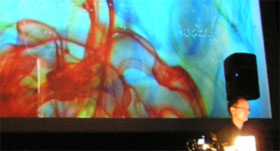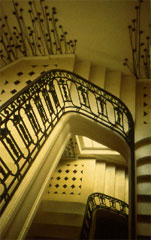Project 3 brings together artists across three generations of technological expansion. They share a joint concern for the sensory and mental experience – placing experience before object, together representing the impetus to extend the realms of experience through technology. The program explores sound arts move away from more traditional venues, into urban/public, and architectural spaces, a theme explored as part of the Media State Media States forum.

Sonic Construction 2, Jon Drummond, performance 2005
The precursor to the Project series was a set of private concerts known as the Rundlestreet/Red-door concert series. Founded in 2003 by Tom Szucs and Michael Yuen, these concerts presented historically important electronic music and new works by young artists. Both installation and performance were key features, as well as the use of technology to realise old works in new ways. Since these concerts, Project 1 New Sonic Worlds (2004 Adelaide Fringe) and Project 2 Apothecary (2005), have provided a platform for exploring the historical and contemporary in electronic sonic arts. Project 1 featured historically important Australian electronic music with performances and installations of Percy Grainger’s and Tristram Cary’s work. Project 2 had a strong emphasis on the interplay between projection and audio, highlighted by Artificial Life composer Luke Harrald’s new work CONflict.
As an expansion upon previous projects, Project 3 encompass four events: SonicSpace, the continuation of the Project concerts series; Silent Music, the Australian premiere of the Canadian born German sound installation artist Robin Minard; Street Cinema, exploring abstract digital Australian screen art; and a series of Artist Talks. For the artists involved, digital technology is a means to realise conceptual material. These artists see digital technology as a tool that holds the flexibility needed in a world where one hears film as much as one sees sound. Inherent in this tool is the concept of unlimited possibility. In the introduction to Barry Vercoe’s seminal computer music programming language CSound, Richard Boulanger writes, “there are no such limitations. In fact, the only limitations are the size of your hard disk, the amount of RAM in your PC and the speed of your CPU — and of course, the limits of your imagination.”[1] The consequence of this statement is the liberation of the artist from a medium. The artist is no longer tied to the default 88 keys on a piano, the manipulation of continuous frames to create moving image, or the presets on end-user computer programs.
A depth of sensory experience is achieved by the fluid combination of the visual and the auditory. The movement of Jon Drummond’s ink drops falling through viscous water, in Sonic Construction 2 (2005), is simply and beautifully mapped to audio. Superficially, the act of dripping has obvious links to other famous drippers: Yoko Ono’s Waterdrop Painting, George Brecht’s Dripping Music, Jackson Pollock and John Cage’s Water Music. When explored with more depth, the act of dripping reveals process as a powerful means of creation by exploiting unfolding events in the present. Through this the audience enters into a deeper experience by becoming witnesses to an event.
This concept resonates with Alvin Lucier I am sitting in a room (1969) which is being performed as part of Project 3’s historical approach to art and technology. Lucier’s work plays multiple generations of recorded speech back into a room and then re-records this sound. The room becomes a large reverberation chamber and the voice decays into the resonate frequencies of the room. The indeterminate process seen in Drummond and Lucier has an obvious link to the Artificial Life works of Paul Brown, Luke Harrald and Gordon Monro. These artists develop environments in which they breed their art digitally. In doing so, they relinquish control of their art to their software.
In contrast to Drummond’s combination of the visual and sonic, Christian Haines prefers to isolate audio to create a more directed experience. He avoids visual stimulus, conceals the process in his work, and creates work that is acousmatic (sound one hears without seeing their originating cause). In Haines’ work the sound is not only detached from the sound source, but the method of creating the sound and its conceptual basis is not revealed. In this way, the audience is allowed to focus solely on the singular auditory sense and explore the ear before the mind, as avant-guard filmmaker Stan Brakhage for example, explored the eye. Although, Haines is much more a composer for the ear and Brakhage a documenter of the eye, the concept of focusing on the singular sense in order to create depth is central to both.

Silent Music, Robin Minard, installation 1998
The work of the Canadian born German sound installationist Robin Minard is specifically “concerned not only with art and its boundaries, but with the continual rapprochement, or even fusion, of art and life.”[2] Minard’s Silent Music comprises hundreds of tiny speakers playing soft sounds to create a place of contemplation and beauty. Minard’s continuous endeavour to fuse art and life lies not in the objects of everyday life as in Marcel Duchamp or more recently Tracy Emin, rather, his sound installations interact with the experiences and spaces that surround us. His work can be seen as the continuation of Erik Satie’s idea of Musique d’ameublement, John Cage’s ‘all-sound’ and Brian Eno Music for Airports fused with the technical ideas of spatialisation and sound construction of Karlheinz Stockhausen and the granular synthesis of Barry Traux.
The exhibitions and performances that make up Project 3 are less concerned with the prescriptive connotations that some object based arts practice explore. Instead, it is an experimental program that resonates with the senses, seeking a depth of experience through the use of technology, and a more complex relationship with the audience.
Michael Yuen
Michael Yuen is an Adelaide based new media curator and interactive installation artist. He is currently the Artistic Director of Project 3 as par of the Adelaide Bank Festival of Arts 2006.
References
[1] Richard Boulanger, The Csound Book, Perspectives in Software Synthesis, Sound design, Signal Processing and Programming. Massachusetts: MIT Press, 2001
[2] Nicolas de Oliveira, Nicola Oxley and Michael Petry, Installation Art, cited in Sound Installation Art, Silent Music by Robin Minard. Berlin: Impressum, 1999
 This work is licensed under a Creative Commons Attribution-NonCommercial-ShareAlike 2.5 Australia.
This work is licensed under a Creative Commons Attribution-NonCommercial-ShareAlike 2.5 Australia.






